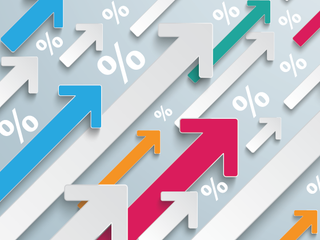Summary
If you’re carrying a balance on a credit card, chances are you’re subject to a higher-than-average APR. Read on to learn how you can avoid getting stuck with costly debt.
The content on this page is accurate as of the posting date; however, some of our partner offers may have expired. Please review our list of best credit cards, or use our CardMatch™ tool to find cards matched to your needs.
The average credit card rate is down considerably, yet it’s within 1 basis point of a record high. Huh? Let me explain.
The data
According to a recent Federal Reserve report, the average credit card that was assessed interest in the third quarter of 2021 was charged 17.13%. That’s way higher than the 16.30% measured in the second quarter and 15.91% in Q1 2021. The record was 17.14% in Q2 2019.
Looking at this from a different angle, according to our weekly rate report, the average credit card currently charges 16.13%. It has barely budged this year. In the middle of the second quarter, it was 16.15%. In the middle of the first quarter, it was 16.12%. And it’s significantly lower than the peak of 17.80%, which was set in July 2019.
That all makes sense because the Federal Reserve made two emergency rate cuts totaling 150 basis points in March 2020 and has left the federal funds rate (which indirectly influences credit card rates) unchanged since then.
Read more from our credit card experts.
So what’s going on here?
Why is the average rate so much higher for accounts assessed interest while other key benchmarks are effectively unchanged in 2021?
In short, this speaks to the K-shaped recovery from the economic crisis brought on by the COVID-19 pandemic. You know, the rich get richer, the poor get poorer. Or in this case, it’s probably more like many in the middle and upper middle classes worked from home and used their stimulus payments to pay down debt while those with lower incomes lost their service industry jobs and struggled to get by. (I’m leaving the truly wealthy out of this – I doubt that Elon Musk, Jeff Bezos and friends are carrying credit card balances from month to month.)
There’s also a key methodology difference between the credit card rates referenced above. Our weekly rate report examines 100 popular credit cards and averages the low end of the APR ranges offered by card issuers. In other words, those are the rates offered to people with better credit. Averaging the high end of the ranges (offered to people with lower credit scores) comes closer to 24%, and the median is roughly 20%.
The Fed’s 17.13% figure represents what people who carried balances were charged. The fact that this has risen sharply while our weekly rate report has remained flat indicates that a higher proportion of people carrying balances have lower credit scores, which are generally correlated with higher rates. These individuals have likely been associated with more job losses and other financial maladies, especially since the average credit score recently set a record high. Many are doing better, but those improvements have not been shared equally.
More key stats
Total credit card balances fell 13% from Q4 2019 to Q3 2021, per the New York Fed (they actually bottomed in Q1 2021 – down 17% from late 2019 – and have ticked upward slightly since then).
At the household level, Experian says the average credit card balance declined from $6,494 in 2019 to $5,525 in early 2021 (a 15% drop).
Yet there’s another contradiction. More than four in 10 Americans (42%) with credit card debt owed more in September 2021 than they did in March 2020, according to our sister site Bankrate.com.
And while the percentage of credit cardholders revolving balances is at its second-lowest point since 2008, that still leaves a majority of active credit card accounts (54%) carrying expensive debt from month to month, as measured by the American Bankers Association.
What this means for you
If you’re wrestling with credit card debt, an excellent strategy is to sign up for a 0% balance transfer card. By moving your existing high-cost debt over to one of these cards, you can avoid interest for up to 21 months. Depending on how much you owe, you could save hundreds or even thousands of dollars. Be sure to take advantage of this to actually make progress paying down your debt; don’t just move it around.
If you need a little more help, consider nonprofit credit counseling. Reputable agencies such as Money Management International and GreenPath can provide you with great advice, consolidate your payments and lower your interest rates, often to something like 7% with a payback cycle lasting up to five years. You could also try something similar on your own via a personal loan.
Whichever way you go about it, paying down your credit card debt needs to be a priority because these rates are usually much higher than other financial products such as mortgages, car loans and student loans. It’s also likely that credit card rates will be headed even higher in the months and years to come. The economic recovery and the surge in inflation should lead the Fed to raise its benchmark rate, and credit card issuers almost always follow. As high as credit card rates are right now, there’s a lot more room for them to go up and not much likelihood that they’ll go down.
Have a question about credit cards? E-mail me at ted.rossman@creditcards.com and I’d be happy to help.
Editorial Disclaimer
The editorial content on this page is based solely on the objective assessment of our writers and is not driven by advertising dollars. It has not been provided or commissioned by the credit card issuers. However, we may receive compensation when you click on links to products from our partners.




